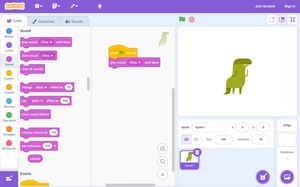
Back Scratch AN سكراتش (لغة برمجة) Arabic স্ক্ৰেচ্ছ্ (প্ৰগ্ৰামিং লেংগুৱেজ) Assamese Скрач Bulgarian স্ক্র্যাচ Bengali/Bangla Scratch (llenguatge de programació) Catalan Scratch Czech Scratch (programmeringssprog) Danish Scratch (Programmiersprache) German Γλώσσα προγραμματισμού Scratch Greek
This article has multiple issues. Please help improve it or discuss these issues on the talk page. (Learn how and when to remove these template messages)
|
Logo used since 16 October 2015 | |
 Scratch 3.0 editor | |
| Paradigm | Event-driven, block-based programming language |
|---|---|
| Developer | Scratch Foundation |
| First appeared | |
| Stable release |
|
| Implementation language | Squeak (Scratch 1.x) ActionScript (Scratch 2.0)[3] HTML5, JavaScript (Scratch 3.0)[3][4] |
| OS | Microsoft Windows, macOS, Linux (via renderer), HTML5 (via web browser), iOS, iPadOS, and Android. |
| License | BSD 3-Clause, GPLv2 and Scratch Source Code License |
| Filename extensions | .sb, .sprite (Scratch 1.x) .sb2, .sprite2 (Scratch 2.0) .sb3, .sprite3 (Scratch 3.0) |
| Website | scratch |
| Influenced by | |
| Logo, Smalltalk, HyperCard, StarLogo, AgentSheets, AgentCubes, Etoys | |
| Influenced | |
| Catrobat,[5] ScratchJr,[6] Snap!,[7] mBlock, Turtlestitch | |
Scratch is a high-level, block-based visual programming language and website aimed primarily at children as an educational tool, with a target audience of ages 8 to 16.[8] Users on the site can create projects on the website using a block-like interface. Scratch was conceived and designed through collaborative National Science Foundation grants awarded to Mitchel Resnick and Yasmin Kafai.[9] Scratch is developed by the MIT Media Lab and has been translated into 70+ languages, being used in most parts of the world.[10] Scratch is taught and used in after-school centers, schools, and colleges, as well as other public knowledge institutions. As of 15 February 2023, community statistics on the language's official website show more than 123 million projects shared by over 103 million users, over 804 million total projects ever created (including unshared projects), and more than 95 million monthly website visits.[10]
Scratch takes its name from a technique used by disk jockeys called "scratching", where vinyl records are clipped together and manipulated on a turntable to produce different sound effects and music. Like scratching, the website lets users mix together different media (including graphics, sound, and other programs) in creative ways by creating and "remixing" projects, like video games, animations, music, and simulations.[11][12]
- ^ Maloney, John; Burd, Leo; Kafai, Yasmin; Rusk, Natalie; Silverman, Brian; Resnick, Mitchel (29–30 January 2004). Scratch: A Sneak Preview. Second International Conference on Creating, Connecting and Collaborating through Computing. Section 6: Project status and next steps. doi:10.1109/C5.2004.33 – via ResearchGate.
- ^ "Scratch Timeline – Scratch Wiki". en.scratch-wiki.info.
- ^ a b Lee, David (28 December 2018). "What you need to know about Scratch 3.0". Computhink. Retrieved 9 February 2024.
- ^ Frang, Corey (28 February 2019). "Porting Scratch from Flash to JavaScript: Performance, Interoperability and Extensions". bocoup. Retrieved 9 February 2024.
- ^ "Catrobat Home". catrobat.org.
- ^ "ScratchJr – Home". scratchjr.org.
- ^ "Snap! Build Your Own Blocks". snap.berkeley.edu.
- ^ scratch, scratch (11 October 2022). "Scratch – About". scratch.mit.edu.
- ^ Cite error: The named reference
:0was invoked but never defined (see the help page). - ^ a b "Community statistics at a glance". scratch.mit.edu. Archived from the original on 6 April 2016. Retrieved 18 May 2019.
- ^ Lamb, Annette; Johnson, Larry (April 2011). "Scratch: Computer Programming for 21st Century Learners" (PDF). Teacher Librarian. 38 (4): 64–68. Retrieved 18 May 2019.
- ^ Schorow, Stephanie (14 May 2007). "Creating from Scratch". MIT News. Archived from the original on 13 October 2018. Retrieved 18 May 2019.